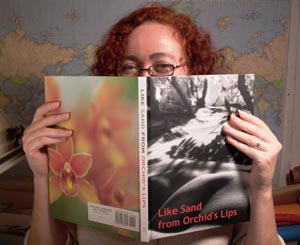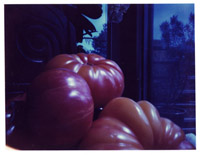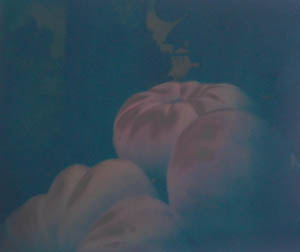Much weirder than it sounds. McSweeney's Internet Tendency: Silly Things My 3-Year-Old Said That I'm Certain the Rest of the World Would Find Sweet and Cute, by Dan Kennedy.
posted by Arlene (Beth)11:42 PM
Thursday, September 21, 2006
I'm taking a brief intermission to get caught up on "special projects" - scanning photographic prints, reading short fiction, and making photograms. I'll be writing about food again soon.
posted by Arlene (Beth)11:25 PM
Wednesday, September 13, 2006
The second photography book my work is published in this year
The binding is lovely.
Two of my three photos are cropped in mysterious ways. One of my photos didn't print with the color balance I had chosen.
The book is much larger dimensionally than I had expected.
Yes, that is one of my images on the back cover (mysteriously cropped on the left side).
I'm still rather surprised.
posted by Arlene (Beth)9:21 PM
Tuesday, September 12, 2006
Bad Lettuce. A woman was walking around downtown with a box she'd picked up from a grocery store, which had been cut short so it was more like a large, shallow tray than a box. Across the front, in red marker, was written "BAD LETTUCE." Which isn't what the woman was carrying. But the phrase, and the image of her walking merrily along with the boldly labeled box sticks in my memory.
posted by Arlene (Beth)9:33 PM
Sunday, September 10, 2006
Saag revisited. I haven't been reporting on it, but I'm still working to improve the saag recipe that I posted on June 7th. I've made several variations, using more or less spinach, several cups of tomato, slightly different balances of spices, different fresh chili peppers in different volumes... I think it could be improved, but my experiments haven't yet taken it to where I want it to be. I think it worked best when served with several, spicier dishes, but when I try to eat it on its own with just rice, papadum, and pickles, it doesn't taste green and/or spinach-y enough. Cutting back on the spices makes a milder dish, but then they seem to need a different balance...
I'll continue to experiment, and will report when I get a variation I like better.
posted by Arlene (Beth)10:00 PM
Saturday, September 09, 2006
Simple potato leek soup
The weather in my part of San Francisco has been cold and grey routinely in recent weeks, and so a soup like this seemed like the perfect thing. This soup is thick and satisfying - and vegan.
Ingredients:
-six cups of water
-three medium potatoes, scrubbed and diced
-about two cups of leeks, washed thorougly and diced
-a large clove of garlic, sliced thinly
-1/4 teaspoon of salt (or to taste)
-freshly ground pepper to taste.
Combine all ingredients (except the pepper) and simmer for 20 - 30 minutes. Puree and serve with freshly ground pepper. This soup can become quite thick as it sits: add water if you want to thin it.
posted by Arlene (Beth)10:08 PM
Thursday, September 07, 2006
The orchid book is here! And my image looks GREAT on the back cover.
I'll post images over the weekend.
posted by Arlene (Beth)10:50 PM
Monday, September 04, 2006
I am such a geek.
Three words: Polaroid pinhole camera. (Oh, and two words: heirloom tomato. Mmmm.)Polaroid technology is still completely amazing to me. It was waaaaay ahead of film and its time. To be able to produce a print anywhere without a darkroom? That is amazingly cool. Very clever photographers who do portraits around the world take along one of Polaroids films that produces both an instant print AND an actual, very large negative, so they can provide a print right then and there to their subject (who they may not be able to get a print to any other way), and bring home a negative to use later. It's just ingenious.
My dad went through a lot of cameras over the years, but Polaroid was never something he used. I may have had one friend who had one, but I never got a chance to use it. So, I thought I'd try it now. Being as geeky as I am, I decided to try Polaroid technology in a geeky way. I knew that Polaroid had made pinhole cameras over the years: I finally found their simplest one - a cardboard box with a film holder attached - on sale with some expired film. It was IRRESISTIBLE. (Did I mention that I am a geek?) And so despite dark, cloudy weather with only moments of random brightness, I decided to try it out over the weekend.
There's something patently ridiculous and wonderful about taking photos with a cardboard box. I kept laughing. (I'm going to have a blast when I make my own, large format camera, perhaps to the point of mad-scientist-like maniacal laughter every time I use it. That should be great!) This must be the 13th or so camera I've acquired, and it's just a cardboard box with a fancy film holder taped to the back of it, and a fancy, machined pinhole taped to the front.. It's preposterous... And it works! Even with truly terrible lighting, and the distressing color shifts that come from long exposures on color film, all four of my test images came out quite clearly. They're terrible images, and I'm showing them here uncorrected and unadjusted, but now I know that the film is good, and the box works. I just have to put more tape on the tripod mount, so that it stops trying to flop off of it... More tape fixes everything!
This particular type of "peel apart" Polaroid film produces a negative, which we're supposed to throw away, because a caustic paste (used in development) remains on the edge of the negative at the end of processing. But the negative itself, especially when it is fresh, is really cool looking.It's sort of like a color daguerreotype, or a very old oil painting that has darkened beneath too many layers of nasty animal varnish. It does dull and become less interesting over time, but there's still something there even now, after four days of aging. I took photos of the negatives about half an hour after development, and I'm posting them here. They are more intriguing to me than the terrible test prints I made.
My eventual plan is to buy some instant black and white film, and do some still life compositions and architectural studies at improbable angles using this pinhole camera. But in the meantime, there are heirloom tomatoes to eat...
posted by Arlene (Beth)11:33 PM
The Nation's FOOD Issue
Yes, it's possible for my favorite news magazine, The Nation, to gush about my favorite topic. The Nation is great for news and politics, and of course food is VERY political. The September 11, 2006 issue of the Nation is its first ever food issue, and it's a good one, edited by Alice Waters, Sylvan Brackett, Anna Lappé. There are many highlights, and I couldn't tear myself away until I finished reading the entire issue. My favorite highlights:
-letters from readers about their favorite food institutions
-a forum with many fabulous contributors on one thing they would change about food in this country, featuring Vandana Shiva, Eric Schlosser, Carlo Petrini, and others
-a revealing article about how "farming is farming" for farmworkers, who labor under lousy conditions with low wages regardless of whether they are working for a big conventional farmer or a big organic one. Hard Labor by Felicia Mello, has some very good points to make. It makes clear that, just because you pay more for organic food, doesn't mean that the workers are necessarily getting a better share. It points out that some organic methods, like hand-weeding, can be absolutely back-breaking, and workers can be injured by doing such jobs all day. But it also makes clear that labor, despite being the biggest cost associated with food production, isn't necessarily the biggest factor in the cost you pay.Is agriculture a zero-sum game, where we must choose between access to affordable healthy food and decent living standards for the people who grow it?It's a good article. And it includes details on "first and only California organic farmer to negotiate a union contract with his workers," and tells how he managed to break the mold and really be different from his competition.
Feenstra, the UC Davis researcher, doesn't think so. "I think it's a false choice," she says. "Most of the money in the food system, about 80 percent, is in the marketing, processing and distribution sector, compared with 20 percent for production. Organic food is not just fruits and vegetables; a lot of it is processed, and that shoots the price up. So when you're talking about labor costs, they're probably going to add 1 or 2 cents, compared with what you're paying for excess packaging, transport from here to there, all those layers of cellophane and bright-colored boxes."
-Eric Schlosser's 'Hog Hell' on the horrid conditions of meat packing plants is illuminating about the numbers game the industry plays along with its regulators.... in 2001, the meatpacking industry had the nation's highest rate of serious injury. It was about three times higher than the national average for factories, despite widespread underreporting of slaughterhouse injuries. The rate of cumulative trauma injury in meatpacking was about thirty-three times higher than the national average. Today it's impossible to know how many meatpacking workers are really getting hurt. In 2002 the Occupational Safety and Health Administration changed the form that companies must use to record meatpacking injuries--and thereby reduced the injury rate by 50 percent.The article also points out that public outrage over Upton Sinclair's book The Jungle was not so much over the treatment of meat industry workers, but over the widespread contamination of the meat itself (!!).
-Mean or Green by Liza Featherstone looks at Wal-Mart's increasingly vast scale of organic products, some of which it plans to ship great distances to achieve efficiencies of scale, which will result in transportation-related pollution. Our current food culture is very polluting:According to research by Brian Halweil of the Worldwatch Institute, our food typically travels 1,500 to 2,500 miles to reach our plate, 25 percent farther than in 1980. By the time we sit down to eat it, a meal from a conventional grocery store has used four to seventeen times more petroleum than a meal made from local ingredients.The article gives me a new reason not to buy Horizon products (which I haven't in the past because they're not local, but there are more!), and points out that the inaccessibility of healthy organic foods to many consumers because of price doesn't necessarily mean that organic food costs too much; rather, it can also mean that people aren't paid well enough if they can't afford the food that's best for them.
And the book reviews are an absolute delight.
It's wonderful to see the high human costs of cheap, unhealthy foods criticized on so many levels, with so many solutions proposed.
The Nation is always a great read: you now have a food-related excuse to pick up this issue.
posted by Arlene (Beth)11:04 PM
Dolfin Chocolate. Chocolate's natural ingredients don't grow around here, but there are all sorts of chocolate companies from around the world whipping up all sorts of splended chocolate treats from places where a cocoa bean could never ever grow. Like Belgium.
Over the past few months, I've been sampling chocolate bars and bite-sized squares from Dolfin, a chocolate maker in Belgium whose treats are available locally at Chocolate Covered (about which I wrote an article for alternativephotography.com) and Rainbow Grocery (rainbowgrocery.org), our fabulous local health food cooperative.
I can remark on the following flavors:
-Chocolat au Lait au thé Vert Sencha du Japon - milk chocolate with sencha (Japanese green tea). The best green tea chocolate bar I have yet tasted. Really great flavor, very smooth.
-Chocolat au Lait Hot Masala - milk chocolate with masala. Cinnamon, cardamom, pepper, clove, and ginger make this like a smooth, spicy, chocolate-filled chai. This tastes so good, you wonder why others haven't thought of this earlier.
-Noir cardamome - dark chocolate with cardamom. Mmmmmmm.
-Orange. Just plain good.
I'll report on some of the more exotic squares (cumin!) later.
posted by Arlene (Beth)10:43 PM
Deep ice tells long climate story (news.bbc.co.uk, 9/04/2006):Carbon dioxide levels are substantially higher now than at anytime in the last 800,000 years, the latest study of ice drilled out of Antarctica confirms.Yes, it's more proof that we're in for nasty climate change. For those who weren't already paying attention.
posted by Arlene (Beth)9:26 PM
Sunday, September 03, 2006
All the cool gadget-oriented blogs remarked on this ages ago, but this is a FOOD blog, so I've taken a bit longer to notice such things. Thoughts About Photography: Medium Format Pinhole Lego Camera (foundphotography.com). Go look. It's both cute and very clever.
posted by Arlene (Beth)7:18 PM


